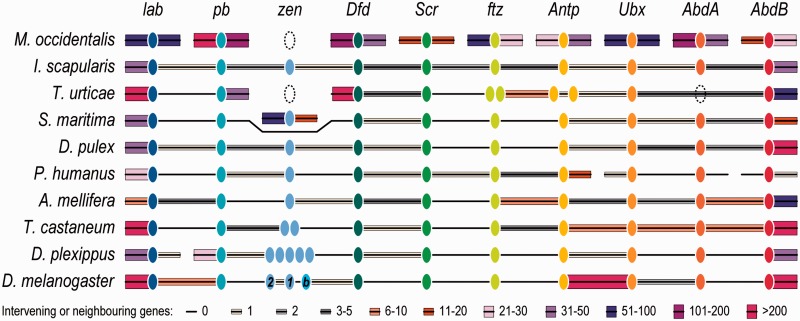Fig. 3.—
Complete atomization of Metaseiulus occidentalis Hox genes. In stark contrast to M. occidentalis, the genomic organization of ten Hox genes from two other arachnids and representative species from seven arthropod lineages shows their generally well-maintained collinearity with no or few intervening genes. This complete atomization of Hox genes is the first reported for any arthropod and highlights the turbulent and dynamic evolutionary history of this predatory mite’s genome. Hox gene orthologs in each species are depicted as color-matched ellipses with dotted ellipses indicating putatively missing genes. Connecting black lines show their scaffold or chromosome collinearity with the number of intervening or neighboring genes indicated by boxes of different heights and colors: Thin gray boxes for 1, 2, or 3–5 intervening or neighboring genes; thicker brown boxes for 6–10 or 11–20 genes; thicker purple boxes for 21–30, 31–50, 51–100, or 101–200 genes; and the thickest bright pink boxes for more than 200 genes. Hox genes: lab, labial; pb, proboscipedia; zen, zerknüllt; Dfd, Deformed; Scr, Sex combs reduced; ftz, fushi tarazu; Antp, Antennapedia; Ubx, Ultrabithorax; AdbA, abdominal A; AbdB, Abdominal B; and labeled in D. melanogaster, 1, zerknüllt; 2, zerknüllt-related; and b, bicoid. Species: A subset from figure 1, plus the centipede Strigamia maritima; the honeybee Apis mellifera; and the monarch butterfly Danaus plexippus.

